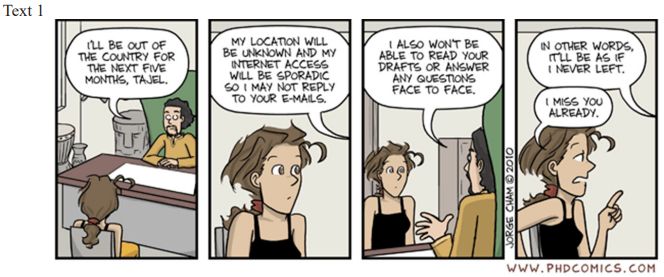Questões de Concurso
Para educação
Foram encontradas 99.386 questões
Resolva questões gratuitamente!
Junte-se a mais de 4 milhões de concurseiros!
Literacy involves having the wherewithal to base one’s interpretive and creative decisions on one’s personal purposes, one’s understanding of the medium one is working with, and the conditions of possibility of reception, acceptance, or rejection by others. The importance of the medium translates into a number of pedagogical goals for language and literacy education:
• To develop learners’ ability to reflect on relationships between language forms and their material contexts.
• To make learners aware of how those relationships change over time and through different mediums and different cultures of reading (i.e., to make learners aware of the historical precedents that have helped shape the communication technologies they use).
• To develop learners’ ability to analyze mediums to identify their ideological (or commercial) underpinnings, and to be aware of how mediums can be used to manipulate consumers and citizens, and to resist such manipulation. To accomplish these goals, teachers should engage learners with questions about how the new media born of the digital age relate to ‘old’ media, and perhaps even ancient media, to allow them to discover what aspects of literacy have remained relatively constant, which have changed, and what the significance of those changes might be.
KERN, Richard. Language, literacy, and technology. Cambridge University Press, 2019.
Based on the text, which of the following best describes the pedagogical goals for language and literacy education in the context of media?
Introductory classroom Young EFL learners in an English language school. Teacher starts the class asking a strong learner, ‘Enzo, how are you?’ The learner responds, ‘Fine, how are you?’. The teacher continues, asking different learners, who respond in turn: Teacher: Sophia, how are you? Student: Fine, how are you? Teacher: Francisco, how are you? Student: Fine, how are you? Teacher: Valentina, how are you? Student: Fine, how are you? If a learner struggles to produce the response, the teacher demonstrates the correct utterance by first mouthing the syllables and then saying them aloud if necessary. The teacher corrects pronunciation, particularly emphasizing the /h/ sound in ‘how’ by breathing on her/his hand as if using a mirror, and drills the prompts with the students. The activity continues until every learner has been asked and has provided the correct response.
In Avaliação da aprendizagem de línguas e os multiletramentos, Duboc (2015) states that the emergence of new literacies in the post-typographical society is closely related to a new understanding of subject, language and meaning making processes. Regarding knowledge construction in both moments discussed by the author, it is correct to say that:

Fonte: Disponível em: https://phdcomics.com/comics.php?f=1374.Acesso em: 30 ago. 2024.

Fonte: Disponível em: https://worldofmirth.com/products/ ugh-as-if-clueless-vinyl-sticker. Acesso em: 30 ago. 2024.
How does the semantic use of ‘as if’ in the final panel of the comic strip in Text 1 contrast with its application in Text 2?

Fonte: Disponível em: https://www.cartoonstock.com/ cartoon?searchID=CS249584. Acesso em: 2 ago. 2024.
The comic cartoons, frequently, highlight an interesting linguistic construction often censured by grammarians: the use of double negatives to articulate a single negation. The critique of double negatives is based on the notion that negation is an absolute concept; something is either present or absent, and adding a second negative into a sentence does not make it more negative than it was before. However, Swan (2005, p. 364) reminds us that “multiple negatives are sometimes used instead of simple positive structures for special stylistic effects. This is rather literary; in spoken English, it can seem unnatural or old-fashioned”. In which of the alternatives bellow there is a purposeful use of a double negative structure for stylistic gains?
The use of the word ‘America’ in the singular and without an adjective may shock the reader. In the expressions ‘God bless America’ or ‘Make America great again’, the part is taken for the whole. In Latin America, people speak more accurately of the Americas - Las Americas. ‘America’ was the baptismal name given in I507 by the German cartographer Martin Waldseemüller in Saint-Diédes-Vosges, based on the voyage of the Italian Amerigo Vespucci to only the southern half of the Western hemisphere. The symbolic cornering of its two continents by English-speaking and Protestant America, ignoring the Romance languages and Catholic traditions in the rest of the New World, has since expressed the relationship of forces between them. In what follows, the word designates less a state and a territory than a certain form of civilization.
DEBRAY, Regis. Civilization. How we all became American. Verso: London, 2019.
According to the text, what does the use of the term ‘America’ without an adjective signify in the context of English-speaking and Protestant America?
According to Dudley-Evans and St John (1998, 10-11), there are several widely-believed essential advantages of ESP courses: they are more motivating than EGP courses as they focus on the learner’s needs, more cost-effective, and the aims are widely accepted by learners. However, the level of motivation depends on the individual learner especially in ESP as learners seek variety from the commonly addressed topics. The problem here is that it is, naturally, easier to do specific work with highly motivated students whereas with less motivated students teachers tend to stick with more general work and topics. In ESP, it is crucial to present any teaching activity in a context regardless of the aim. Dudley-Evans and St John distinguish in this respect “carrier content” and “real content” (1998, 11): carrier content describes an authentic topic to teach the real content which is the language of process.
KOPPITSCH, Gerlinde. Teaching English for Specific Purposes. An action research project. Master Thesis. Alpen-Adria-Universität Klagenfurt, Klagenfurt, 2019.
According to the text, what is a crucial aspect of teaching English for Specific Purposes (ESP) courses?
What are the four main elements of the communicative competence framework presented by Canale and Swain (1980) which is the foundation of many studies on English language teaching like Almeida Filho (2005)?
BAKHTIN, Mikhail. Os gêneros do discurso. In: Estética da criação verbal. 2ª ed. São Paulo: Martins Fontes, 1997.
Considerando essas premissas, imagine que você é responsável por escrever um artigo de opinião para um jornal de grande circulação. O tema é “O impacto das redes sociais na formação da identidade dos jovens”. O público-alvo são leitores de faixa etária variada, com diferentes níveis de escolaridade e acesso à informação.
Qual alternativa apresenta a melhor abordagem para garantir a adequação e eficácia do texto ao contexto de produção e ao público-alvo?
Bakhtin (1997) enfatiza que a construção composicional e o estilo do gênero literário envolvem o uso de recursos coesivos para garantir a coerência e a continuidade do texto. Todorov (1971) complementa que esses elementos são fundamentais para a progressão temática e a construção da narrativa.
BAKHTIN, Mikhail. Estética da criação verbal. 2ª ed. São Paulo: Martins Fontes, 1997.
TODOROV, Tzvetan. Introdução à literatura fantástica. São Paulo: Editora Perspectiva, 1971.
Com base nessas premissas, qual é a função dos elementos coesivos para manter a coerência e progressão temática do texto abaixo? “Os dias eram longos e áridos, e o sol castigava sem piedade as ruas desertas. O vento, que antes soprava suave, agora trazia apenas poeira e silêncio. No entanto, à noite, quando as estrelas surgiam no céu, uma esperança tímida parecia renascer nas almas cansadas. Era como se o brilho distante iluminasse, mesmo que por um instante, os corações que se haviam acostumado à escuridão.”
Fonte: Cardoso, Rafael. O Sol e a Sombra. São Paulo: Editora XYZ, 2018.,
De acordo com o Manual de Redação da Presidência da República (2002), os aspectos relevantes da sistemática externa de uma lei se mostram pelo exame de sua estrutura básica. Qual opção abaixo corresponde às condições basilares para a elaboração e organização do artigo, que é a unidade básica para apresentação, divisão ou agrupamento de assuntos em texto normativo?
Bloom (1994) discute como os autores e suas obras dialogam com as tradições literárias e com o público ao longo do tempo, enquanto Bakhtin (1997) enfatiza a importância da historicidade e da recepção dos textos na compreensão de sua relevância cultural e estética.
BLOOM, Harold. O Cânone Ocidental: Os Livros e o Legado da Literatura. Rio de Janeiro: Editora Record, 1994.
BAKHTIN, Mikhail. Estética da criação verbal. 2ª ed. São Paulo: Martins Fontes, 1997.
No exemplo do trecho abaixo, qual alternativa melhor elucida a importância e o impacto da historicidade dos textos e o diálogo entre obras e contextos históricos para a prática da leitura literária?
Os romances de Machado de Assis, produzidos no final do século XIX, refletiam as tensões sociais e políticas do Brasil Imperial. A circulação dessas obras nas livrarias e a recepção crítica da época mostram um diálogo constante entre a literatura e o contexto histórico, revelando a habilidade do autor em manter elementos da tradição literária enquanto rompe com convenções estéticas estabelecidas.
Em relação às tensões normais, pode-se afirmar que: